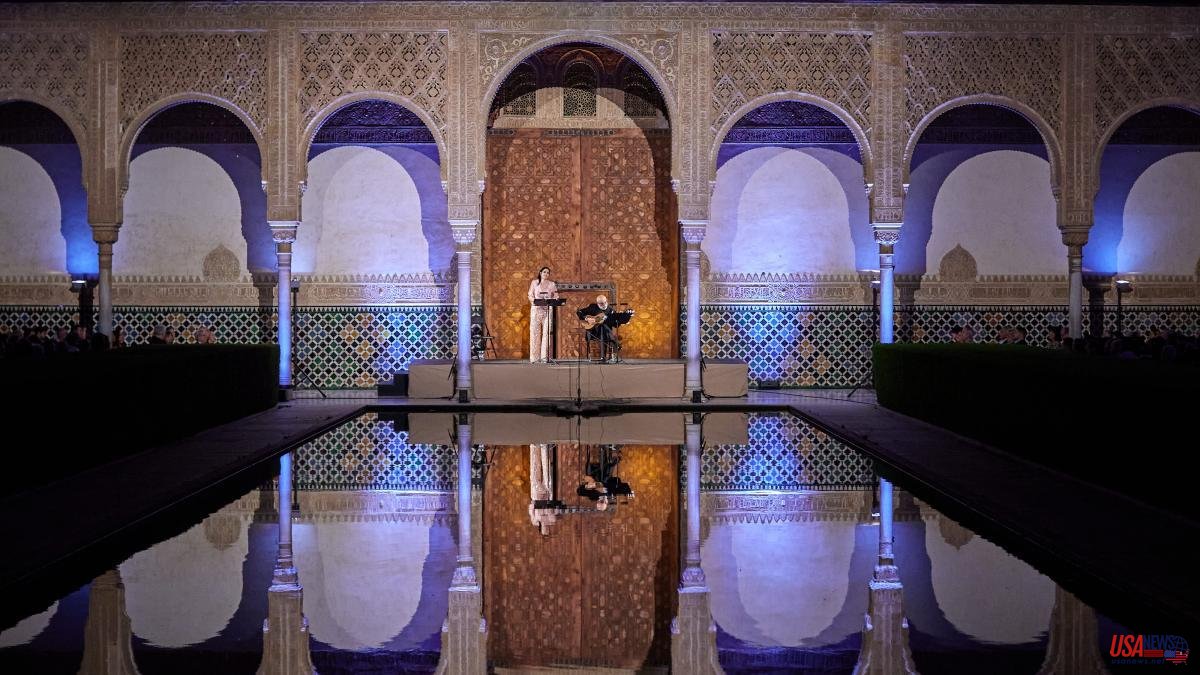The International Festival of Music and Dance of Granada is a racehorse with the bridles of a pony. As much as the pandemic has further reduced its percentage of international audiences, the potential planetary reach of its proposal is indisputable. Because, to begin with, there is no other that has the spiritual power that emanates from the Alhambra.
Taking a walk through the palatial complex, letting yourself be impregnated by the Nasrid sensibility of its gardens, its rose gardens or the successive fountains and ponds that vary in iridescence with the sun, is the necessary prelude to ingesting the best music and dance. Shows that also take place most of the time in the same spaces, with the very fine acoustics of a Patio de los Arrayanes or the views that the Generalife Theater offers of the Alhambra.
And yet, Granada cannot even dream of being the Latin Salzburg at the moment. Not even the Aix-en-Provence of the South. The centennial Austrian festival has a budget of 66 million euros; the French, which started in 1881, 23 million. And Granada –which although these days celebrates its 71st edition began in 1883 as the Corpus Christi Festival– has 3.3...
The recipe for it to occupy the position it deserves is universal: that the responsible authorities stop seeing culture as an expense and understand it as an investment. The chronicle of a single day, that of last Sunday, is representative of that intensity: at noon, on the Royal Hospital Cruise, the cellist Jean-Guihen Queyras blurred the passage of time with a dialogue between the intrinsic modernity of Bach and his constant influence on later composers, such as Kurtág.
"When a few years ago in Salzburg they had a budget of 52 million euros, they saw that the return was 257 million, and they did not hesitate to expand it," says cultural manager Antonio Moral, director of the Granada festival since December 2019. He is counted among the programmers who insisted on not canceling when the pandemic shook culture. It was not only necessary to be prudent with health and safety measures, but also with the economy of so many professionals who drive this event.
Right in the middle of its current edition, its 102 shows register an occupational average of 80% and box office receipts exceed one million euros for the first time. Moral has increased the number of tickets for sale by 25%: if the usual was 32,000 or 33,000, this year it has launched 41,000. A record that remains for his annals, although as a figure it should be usual.
In fact, it would be if that Atlántida by Falla had continued with the production of La Fura dels Baus that Josep Pons, then head of the City of Granada Orchestra, the critic Jorge de Persia devised while strolling through the Alhambra in 1996. , who had put together the Falla Archive, and who was directing the contest at the time, Alfredo Aracil.
That mythical operatic production was the festival's pike in Flanders to become a cultural event with its own stamp. But the fact is that it cost as much as the rest of the programming. Therefore, when it came to moving forward with more of their own productions, they decided to leave the one in Granada at a festival of concerts and dance shows.
And this seems to be the crossroads facing Antonio Moral, the programmer whose people skills are the envy of the profession and who is precisely being forced by the pandemic to reinvent himself to encourage foreign visitors. At the moment 25% of the public is coming from outside Granada. And in what remains of the programming, until July 10 (see box), the sensitivity with which it is designed is observed.
The chronicle of a single day, that of last Sunday, is representative of that intensity: at noon, on the Royal Hospital Cruise, the cellist Jean-Guihen Queyras blurred the passage of time with a dialogue between the intrinsic modernity of Bach and his constant influence on later composers, such as Kurtág.
At sunset, and after a walk through the Alhambra, it is the mythical Grigory Sokolov who leaves stuttering fans who have come to listen to his disarming Brahms or his colossal Beethoven, sheltered by the extraordinary acoustics of the Manuel de Falla Auditorium. Then, wandering steadily, we arrive on time for the recital by Alaskan soprano Vivica Genaux who, accompanied by guitar, delicately explores the art of vocal variation. The ecstasy in the Patio de los Arrayanes is total.
The following morning, Monday, María Pagés collects, just as Josep Pons did a few days ago, the Festival's Gold Medal. But in her case at the hands of the other recent Princess of Asturias award winner, cantaora Carmen Linares, with whom the Sevillian bailaora is also in clear harmony. "Because of her commitment to the international dissemination of flamenco dance and her ability to renew this art," says Antonio Moral in the presence of the local authorities.
Pagés' partner and artistic tandem, the playwright El Arbi El Harti, expands in an aside on the art of the Nasrids and the unusual beauty of the Alhambra: "They came out of the desert and adopted civilizations that became a paradigm of spirituality," he says. -. But it is not something that emanates from nowhere, they inherit from the Umayyads and the Abbasids. They continue with an investigation around space-time and always with a mystical mission”.
The festival uses up to a dozen venues in the city for paid shows. The circular courtyard of the imposing Palace of Emperor Carlos V, grandson of the Catholic Monarchs, who appears like a UFO embedded in the palaces of the Alhambra, houses the main musical dishes while the Generalife Theater is used for dance performances.
In the rest of the city there is also festival activity in emblematic spaces such as the García Lorca Center, the San Jerónimo Monastery or the San Salvador Church. And Antonio Moral is incorporating a new one every year, like the Chumbera, for flamenco, or the Patio de los Inocentes of the Royal Hospital, "so appropriate for a Monteverdi program" that he did last year.
But the contest has its popular and free extension in the so-called FEX. Tomorrow, Wednesday, he performs, for example, in the Huerta de San Vicente, where the summer home of the poet's family is located, the Gani Mirzo Band, the music group with Kurdish roots that fuses the sound of the East and flamenco.
The question is how it is possible to weigh down a festival that already in the 19th century gave the city the first opportunity to get to know and enjoy the great European musical repertoire with great orchestras. An appointment with a 139-year-old brand image, in which exactly a century ago García Lorca, Falla and other intellectuals and artists of the time such as Andrés Segovia, Fernando de los Ríos, Zuloaga, Manuel Ángeles Ortiz, Turina or Rusiñol convened the Cante Jondo contest and founded modern flamenco...
How can you stop the international projection of a legacy that includes concerts by Andrés Segovia in the most beautiful Arab patios of the Alhambra, or by Herbert von Karajan or Sergiu Celibidache conducting in the Palace of Carlos V?
Perhaps the formula of the consortium that led to the appearance of the autonomous communities has left the project an orphan, in the hands of everyone and no one. Another international project that becomes more local?













